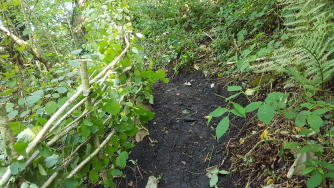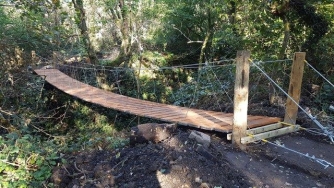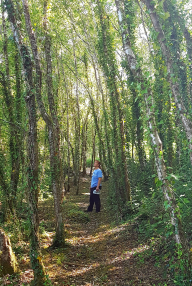
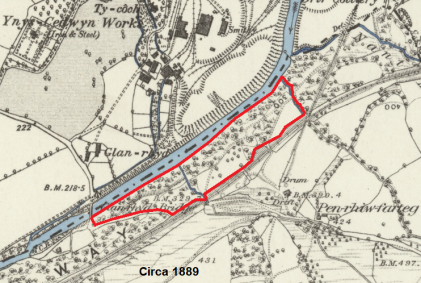
Woodland management
Not all woodlands are the same. Coed Glannant is an ancient woodland and by that, people visualise the sort of woodland that Robin of Loxley and John Little hid out in; however, this is not the case.
The term 'ancient woodland' merely means that a wood has occupied the site for more than three-hundred years, it doesn't not tell us anything about the trees, their type and age, or the flora and fora.
Coed Glannant has a few really big Oaks and Beech with huge trunks, set amongst smaller Alder, Birch and Hazel etc. and also some compartments of younger trees, and many are less than twenty years old.
Coed Glannant has mining history too, so man has changed many aspects of this 'ancient' woodland over the years.
Mining needs wood, and not the soft wood pine that covers much of the UK either; the miners needed hard woods which would stand the test of time.
From the early 1800's all of Coed Glannant's hard woods were converted into pit props, rail track sleepers and all manner of other mining related things; only the smaller trees and the ones in awkward places were left standing, so most of trees found today can be dated back to when the miners left the area and it woodland regenerated.
About 10% of the woodland is Ash and most of these trees are dying or are already dead and dropping limbs.
Its a shame to see these big trees go however their demise opens holes in the forest canopy through which the light can penetrate and this light allows younger saplings to race to fill the space.
We intend replacing the Ash with Oak, Beech, Aspen and other long-standing species but it will take time for them to reach maturity.
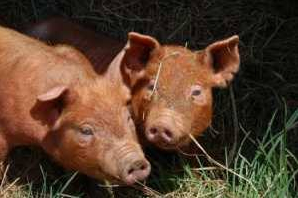

Woodland animals
Coed Glannant is heavily overgrown with Bramble, Ivy and Bracken (Bramble being the predominance). It is so overgrown, it is impossible to walk through, explore or even to survey the ecology.
Some open areas are needed as these increase the diversity of the flora which in turn increases the diversity of the fauna; man is included in our list of fauna and at the moment, man cannot enjoy the beauty of the woodland.
Controlling the wild woodland in a natural way could be achieved with Pigs; we hope to use Tamworth's as they are hardy, outdoor pigs which lend themselves to woodland management.
Some may argue that the woodland should be left alone will be fine as it is; they will say that it has managed quite well for hundreds of years and will self manage for the next hundred years too.
Some aspects of this is correct however within the self-managing balance was the wild boar that grubbed through the ground, the deer that ate some of the saplings and the wolf that ate some of the deer and these are now missing. This has allowed some species to run amok that has a 'knock on' affect on other areas of the woodland.
In Coed Glannant, the bramble has covered 90% of the ground; it's dense cover reduces the air movement which stops the ground going through its normal wetting and drying cycles; it shades the ground which prevents other flora from establishing and in doing this it changes the soil structure too.
Personally, we like the bramble, we like its wild look, we like eating its fruit and fermenting it too, but we like to see, smell, and eat other species too - a healthy balance is needed.
How effective the pigs will be, we don't know so we will start small with six weaners and watch what they do.
Ideally the pigs will free range the whole woodland however we may end up containing them in some areas or excluding them from others.
At approximately 34 weeks, the pigs will go to market as we hope their work will be done and the pigs will be replaced with a few goats which are less disruptive.
Public footpaths
A permissive footpath runs diagonally across part of the woodland but it is our intention to create many more.
Our reasoning is two-fold.
Firstly, there are many other beautiful areas of the woodland that currently the rambler doesn't see.
Secondly, we have identified that the Varteg Hill road is narrow and dangerous for both cars and walkers so it is our intention to create a safe path for walkers which is away from the road.
During our explorations of the woodland, we have discovered many abandoned footpaths which tell of times when the bramble didn't cover all of the ground and people could walk freely.
We identified one specific track which looked like it had been used as a footpath in the past and talking to the locals confirmed that it was indeed a footpath circa 20 years ago.
This track enters the woodland at the bottom of the road (by the road bridge across the river) and from here the walker can wend their way up the hill without stepping foot on the road.
At the opposite end of the woodland we rediscovered and old miners track and this has been cleared back to become another footpath too.
In time we will create a footpath right around the the woodland and hopefully link this to a path down to the waterfalls too.
